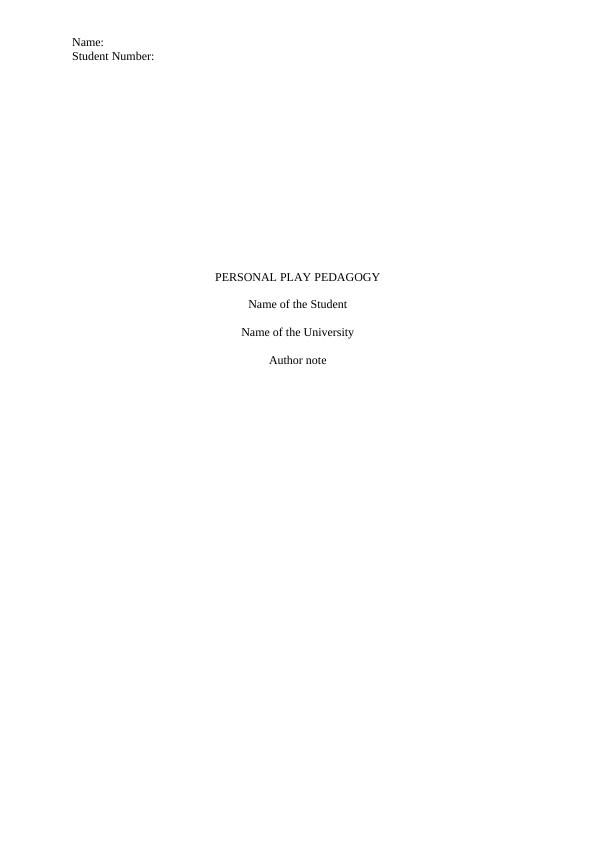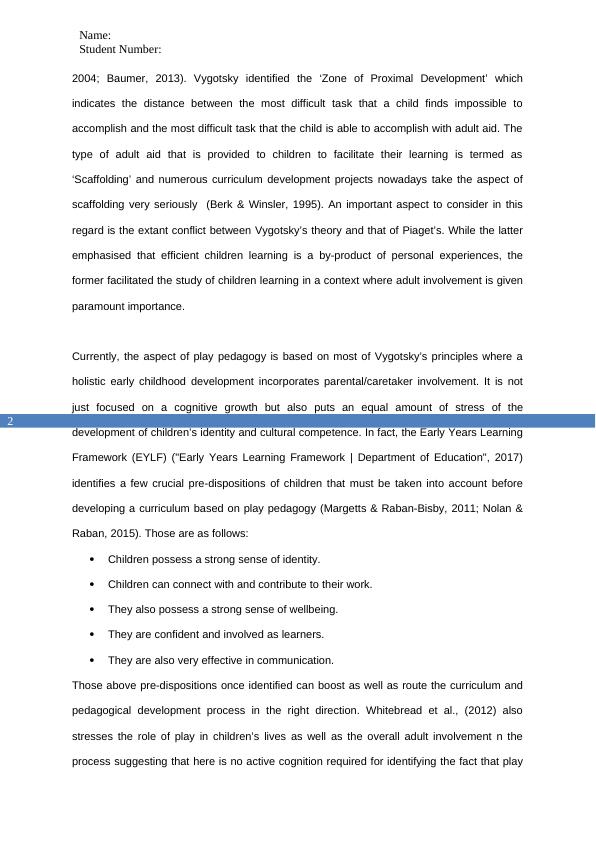Personal Play Pedagogy
Added on 2022-11-25
8 Pages2192 Words238 Views
Name:
Student Number:
PERSONAL PLAY PEDAGOGY
Name of the Student
Name of the University
Author note
Student Number:
PERSONAL PLAY PEDAGOGY
Name of the Student
Name of the University
Author note

Name:
Student Number:
1
Introduction
One of the most important aspects of growth and development is education. By education, it
is not always meant the knowledge of language or topics in particular but an overall
development of the cognitive framework as well. The early years of a child are crucial
because the developing brain is capable of taking in a lot of information, processing and
analysing them. This is why in the current educational context, early childhood education is
being given paramount importance and the aspects of childhood growth and development
stands out as one of the most crucial determiners of a holistic socio – cognitive
development. This essay deals with the topic of childhood learning through the angle of
‘play’ pedagogy whose main focus is to involve the parents/caretakers/caring adults, actively
in the teaching learning experience involving a child. With reference to early education
curricula and national Early Years Learning Framework ("Early Years Learning Framework |
Department of Education", 2017) alongside a variety of theoretical perspectives and
academic articles, this essay will highlight the importance and significance of the
development of a play pedagogy in an early childhood education system, followed by a
discussion on a personalised play pedagogy for an educational program involving children
aged 2 – 5 years. Finally the essay will also, through an in depth study of the Early Years
learning framework ("Early Years Learning Framework | Department of Education", 2017)
along with the principles entailed in the framework, attempt to highlight the implications of an
effective early education program based on play pedagogy.
Discussion.
The term ‘play pedagogy’ derives its meaning from play being a part of childhood
experience. It advocates a joint play involvement of both adult and child in activities “that are
respectful of the child’s culture, creativity and spontaneity” (Baumer, 2013 p. 2). Play
pedagogy was founded by Gunilla Lindqvist (Nilsson, 2009), grounded in a less popular
Vygotsky educational approach titled “Imagination and Creativity in Childhood” (Vygotsky,
Student Number:
1
Introduction
One of the most important aspects of growth and development is education. By education, it
is not always meant the knowledge of language or topics in particular but an overall
development of the cognitive framework as well. The early years of a child are crucial
because the developing brain is capable of taking in a lot of information, processing and
analysing them. This is why in the current educational context, early childhood education is
being given paramount importance and the aspects of childhood growth and development
stands out as one of the most crucial determiners of a holistic socio – cognitive
development. This essay deals with the topic of childhood learning through the angle of
‘play’ pedagogy whose main focus is to involve the parents/caretakers/caring adults, actively
in the teaching learning experience involving a child. With reference to early education
curricula and national Early Years Learning Framework ("Early Years Learning Framework |
Department of Education", 2017) alongside a variety of theoretical perspectives and
academic articles, this essay will highlight the importance and significance of the
development of a play pedagogy in an early childhood education system, followed by a
discussion on a personalised play pedagogy for an educational program involving children
aged 2 – 5 years. Finally the essay will also, through an in depth study of the Early Years
learning framework ("Early Years Learning Framework | Department of Education", 2017)
along with the principles entailed in the framework, attempt to highlight the implications of an
effective early education program based on play pedagogy.
Discussion.
The term ‘play pedagogy’ derives its meaning from play being a part of childhood
experience. It advocates a joint play involvement of both adult and child in activities “that are
respectful of the child’s culture, creativity and spontaneity” (Baumer, 2013 p. 2). Play
pedagogy was founded by Gunilla Lindqvist (Nilsson, 2009), grounded in a less popular
Vygotsky educational approach titled “Imagination and Creativity in Childhood” (Vygotsky,

Name:
Student Number:
2
2004; Baumer, 2013). Vygotsky identified the ‘Zone of Proximal Development’ which
indicates the distance between the most difficult task that a child finds impossible to
accomplish and the most difficult task that the child is able to accomplish with adult aid. The
type of adult aid that is provided to children to facilitate their learning is termed as
‘Scaffolding’ and numerous curriculum development projects nowadays take the aspect of
scaffolding very seriously (Berk & Winsler, 1995). An important aspect to consider in this
regard is the extant conflict between Vygotsky’s theory and that of Piaget’s. While the latter
emphasised that efficient children learning is a by-product of personal experiences, the
former facilitated the study of children learning in a context where adult involvement is given
paramount importance.
Currently, the aspect of play pedagogy is based on most of Vygotsky’s principles where a
holistic early childhood development incorporates parental/caretaker involvement. It is not
just focused on a cognitive growth but also puts an equal amount of stress of the
development of children’s identity and cultural competence. In fact, the Early Years Learning
Framework (EYLF) ("Early Years Learning Framework | Department of Education", 2017)
identifies a few crucial pre-dispositions of children that must be taken into account before
developing a curriculum based on play pedagogy (Margetts & Raban-Bisby, 2011; Nolan &
Raban, 2015). Those are as follows:
Children possess a strong sense of identity.
Children can connect with and contribute to their work.
They also possess a strong sense of wellbeing.
They are confident and involved as learners.
They are also very effective in communication.
Those above pre-dispositions once identified can boost as well as route the curriculum and
pedagogical development process in the right direction. Whitebread et al., (2012) also
stresses the role of play in children’s lives as well as the overall adult involvement n the
process suggesting that here is no active cognition required for identifying the fact that play
Student Number:
2
2004; Baumer, 2013). Vygotsky identified the ‘Zone of Proximal Development’ which
indicates the distance between the most difficult task that a child finds impossible to
accomplish and the most difficult task that the child is able to accomplish with adult aid. The
type of adult aid that is provided to children to facilitate their learning is termed as
‘Scaffolding’ and numerous curriculum development projects nowadays take the aspect of
scaffolding very seriously (Berk & Winsler, 1995). An important aspect to consider in this
regard is the extant conflict between Vygotsky’s theory and that of Piaget’s. While the latter
emphasised that efficient children learning is a by-product of personal experiences, the
former facilitated the study of children learning in a context where adult involvement is given
paramount importance.
Currently, the aspect of play pedagogy is based on most of Vygotsky’s principles where a
holistic early childhood development incorporates parental/caretaker involvement. It is not
just focused on a cognitive growth but also puts an equal amount of stress of the
development of children’s identity and cultural competence. In fact, the Early Years Learning
Framework (EYLF) ("Early Years Learning Framework | Department of Education", 2017)
identifies a few crucial pre-dispositions of children that must be taken into account before
developing a curriculum based on play pedagogy (Margetts & Raban-Bisby, 2011; Nolan &
Raban, 2015). Those are as follows:
Children possess a strong sense of identity.
Children can connect with and contribute to their work.
They also possess a strong sense of wellbeing.
They are confident and involved as learners.
They are also very effective in communication.
Those above pre-dispositions once identified can boost as well as route the curriculum and
pedagogical development process in the right direction. Whitebread et al., (2012) also
stresses the role of play in children’s lives as well as the overall adult involvement n the
process suggesting that here is no active cognition required for identifying the fact that play

End of preview
Want to access all the pages? Upload your documents or become a member.
Related Documents
Play Pedagogy Australia Essay 2022lg...
|9
|2530
|19
(Solved) Essay on Vygotsky Theorylg...
|15
|4438
|43
Pedagogy and Curriculum in the Early Yearslg...
|12
|4456
|147
Early Childhood Education Theories: Bronfenbrenner, Vygotsky, Piagetlg...
|6
|823
|133
The Constructivist vs. Critical Theory Paradigm in Child Developmentlg...
|8
|1833
|169
Teaching and Learning with Art: Activities for Early Childhood Developmentlg...
|24
|3922
|157
